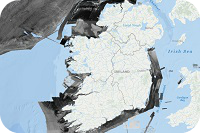Polygon
Type of resources
Available actions
Topics
INSPIRE themes
Keywords
Contact for the resource
Provided by
Years
Formats
Representation types
Update frequencies
-
The location of seabed gas pipeline infrastructure from Cork to the Kinsale platform, Mayo to the Corrib platform and the international connector routes between Ireland and Scotland.
-
This dataset shows spawning and nursery grounds of commercially important species, in particular: Hake, Mackerel, Horse Mackerel, Atlantic Cod, Herring, Haddock, Megrim, Blue Whiting, Black Belly Angler Monkfish, White Belly Angler Monkfish and Whiting. Spawning area, spawning grounds and spawning beds are considered the locations where commercially important species of fish leave their eggs for fertilisation. Spawn consists of the reproductive cells (gametes) of fish, some of which will become fertilised and produce offspring. The process of spawning typically involves females releasing ova (unfertilized eggs) into the water, often in large quantities, while males simultaneously or sequentially release spermatozoa (milt) to fertilise the eggs. Spawning grounds help understand the species distribution of a particular commerically important fish. Marine nursery areas are habitats that promote the survival of young commercially important fish species. Many of these creatures are important to humans in fisheries and seafood. These habitats are essential for the reproduction and understanding of the geographical species distribution. Take them away or degrade them, and the production of commercially harvested species will decline or cease altogether. Spawning and Nursery grounds are areas where both spawning and nursery grounds overlap.
-

INFOMAR backscatter data is measured primarily by multibeam (MBES) and also singlebeam (SBES) echosounder devices. MBES transducers transmit multiple a high frequency pulses of sound from beneath a vessel in a fan shape down to the seabed. The amount of energy reflected back to the vessel for each pulse of sound is termed the backscatter. The amount of energy returned will depend on the seabed type, for example a softer bottom such as mud will return a weaker signal than a harder bottom, like rock. Backscatter therefore can be used to infer seabed type.
 Metadata catalogue
Metadata catalogue